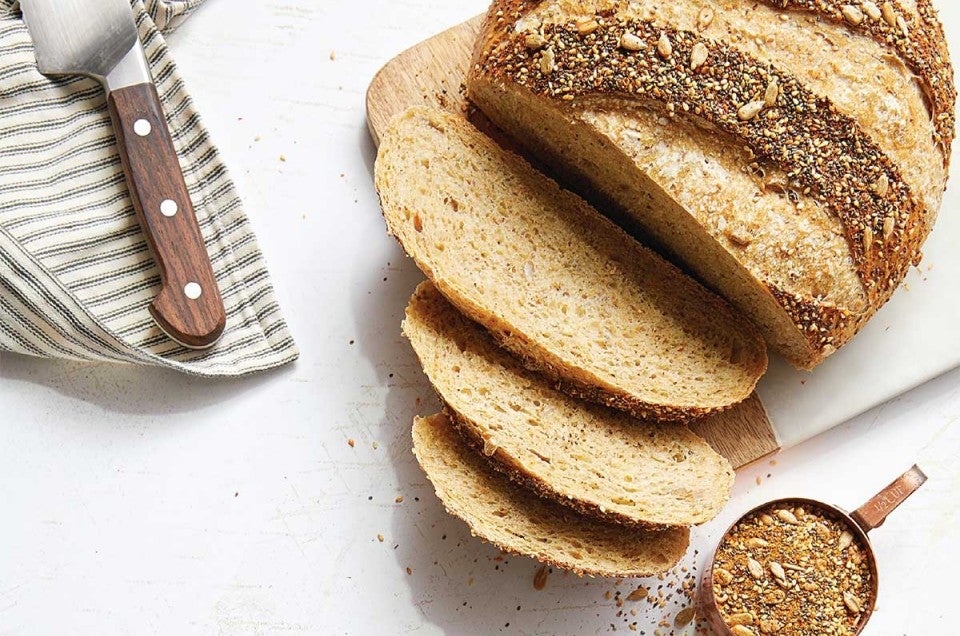


I'm a creature of habit. Like my yogi friends that hit the mat each day or our chickens on their morning stroll, routine helps me *bake* it through the week.
But sometimes I need a change — a tweak, a spark, a bucket of cold water? — to break the routine.
Our daily bread at home is what we call “Maura’s Bread," also known as Pain de Campagne. It’s a sourdough recipe from my friend Maura that can be made in the cracks of the day. I would even go so far as to say that our home is defined by this sturdy loaf on our table.
But what if we want to change it up a little? What if you have a loaf that’s your steady companion, but you’re feeling frisky for a change? Whether you’re making Maura’s Bread or another dependable recipe of your choosing, here are a few ways to keep your bread-making routine spicy and interesting.
Adding seeds, flakes, cornmeal, or even coarse wheat bran to the exterior of a loaf is one of the easiest, quickest ways to bring some “Wow!” to the table. From sesame or sunflower seeds to flaked oats, barley, or even Everything Bagel Topping, sticking additions to the outside of a loaf might be my favorite trick ever. These nuts, seeds, and flakes intensify during baking to give your bread a whole new flavor and textural dimension.
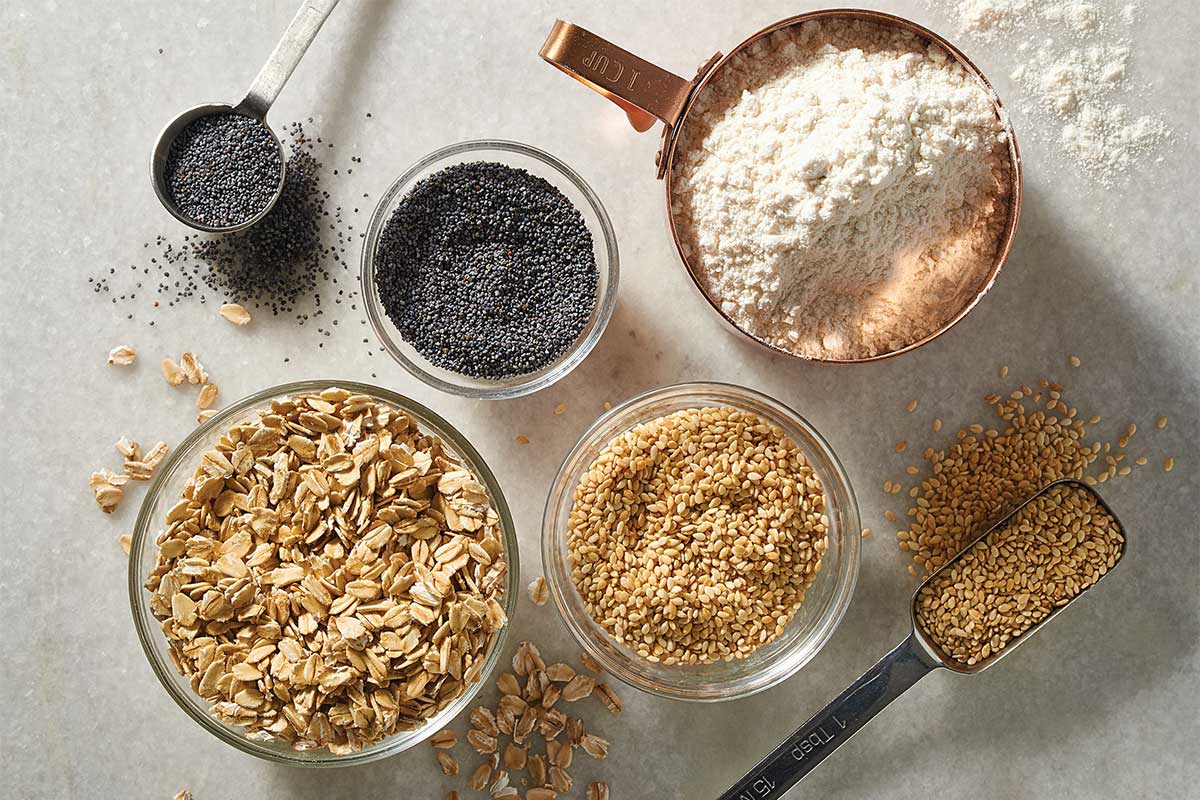
To add a seeded crust to a loaf or rolls, you’ll first make a seed tray. Thoroughly moisten a dish towel, then wring out some of the water, leaving it quite wet to the touch. Spread the towel flat onto a baking sheet or tray. Pour a generous quantity of seeds, oats, bran, or more — a single variety or a wild blend of your choosing — onto a separate baking tray.
After shaping your bread, place what will become the top surface of your finished loaf onto the damp dish towel, gently rocking it back and forth to moisten.
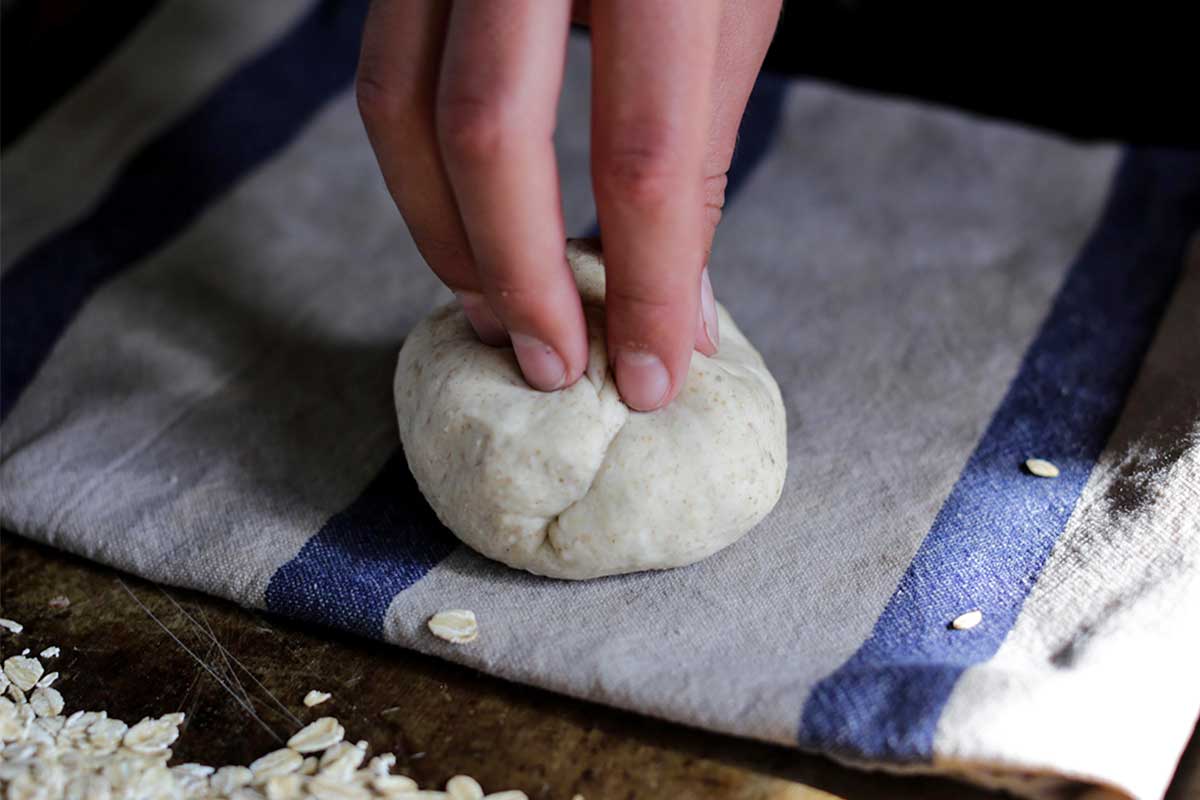
Then place the moistened portion of the dough onto the seed bed, rocking in a similar fashion to fully coat the loaf with seeds (or any topping of your choosing, like oats as demonstrated here).
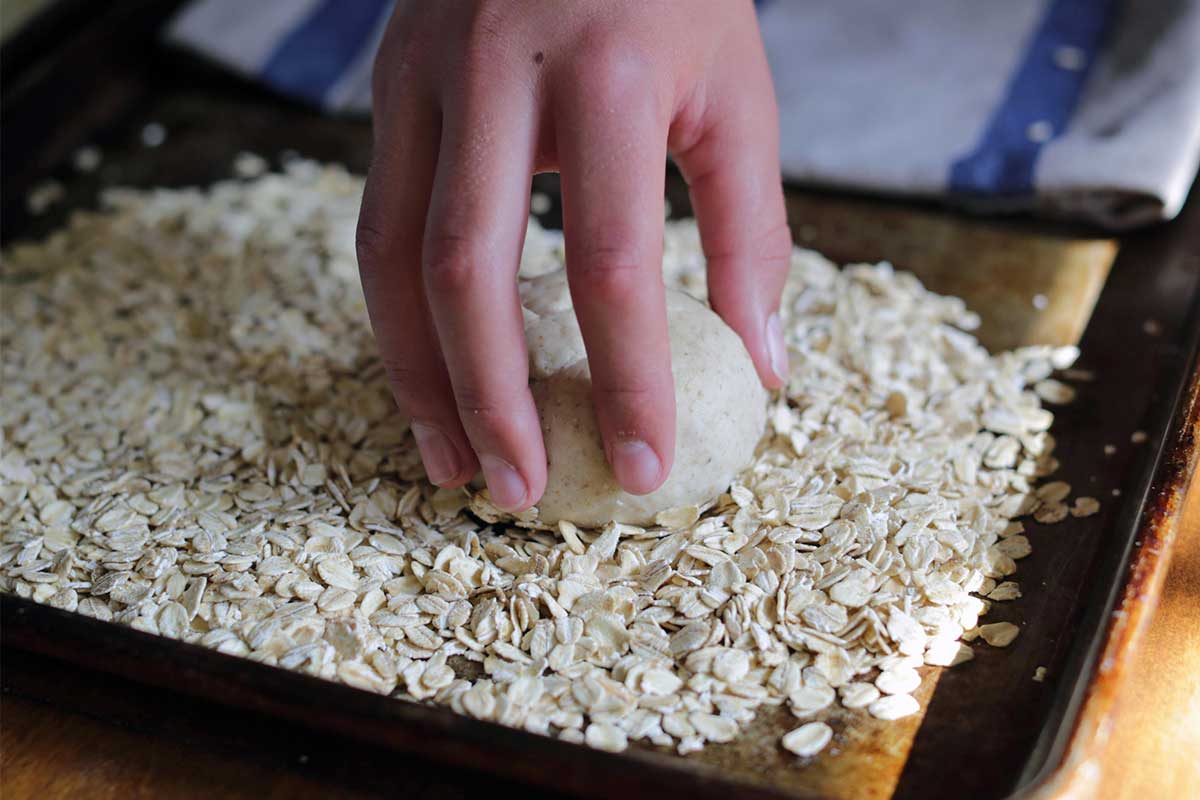
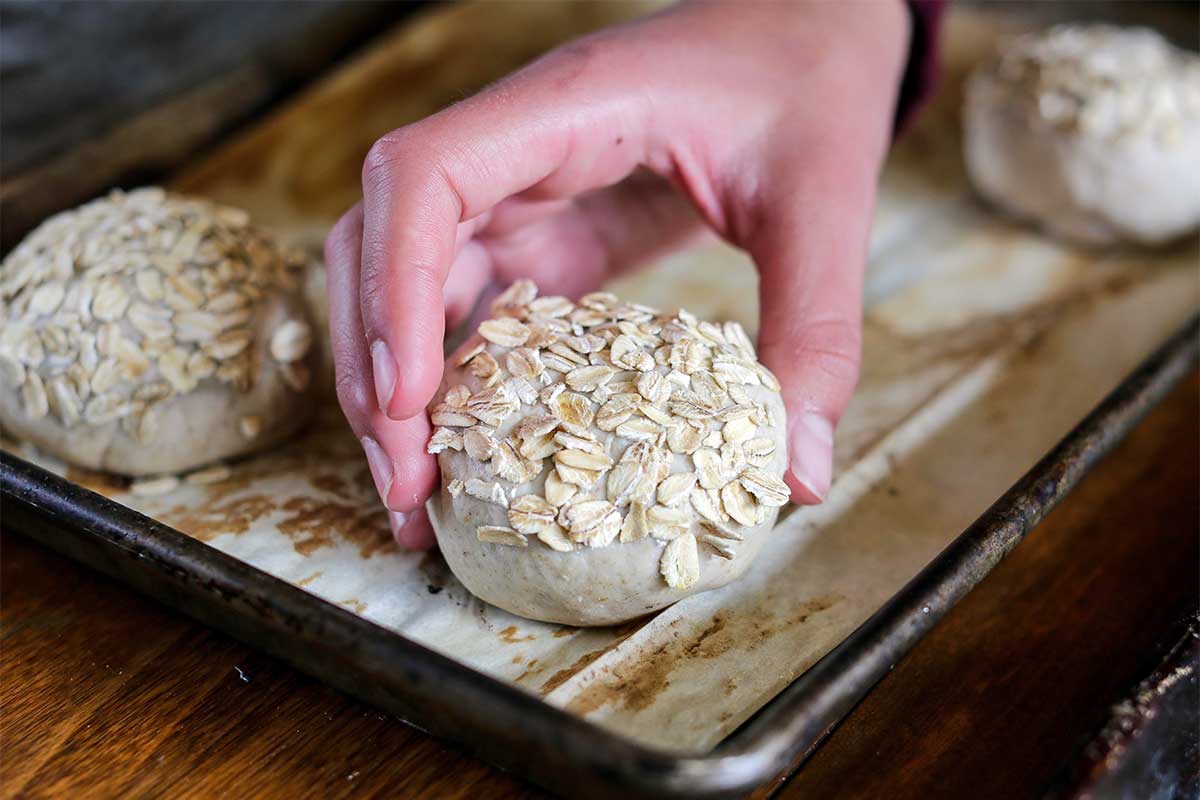
Let it sit for a few seconds on the seed bed while the seeds adhere, then place the loaf into your banneton or proofing vessel until baking. If using a banneton, it will be seed-side down; if you’re proofing in the baking vessel, place it seed-side up.
Pro tips:
Many of the things I like on the outside of a loaf are equally good on the inside. Chopped nuts, soaked grains, or flakes such as oat or barley boost color, texture, and flavor in delightful ways. For an off-the-shelf grain mixture, you can use our Harvest Grains Blend, or dream up your own creative combination. As you explore, don’t overlook aromatics — a sprinkle of fennel, caraway, nigella, or buckwheat groats adds fantastic aromas.
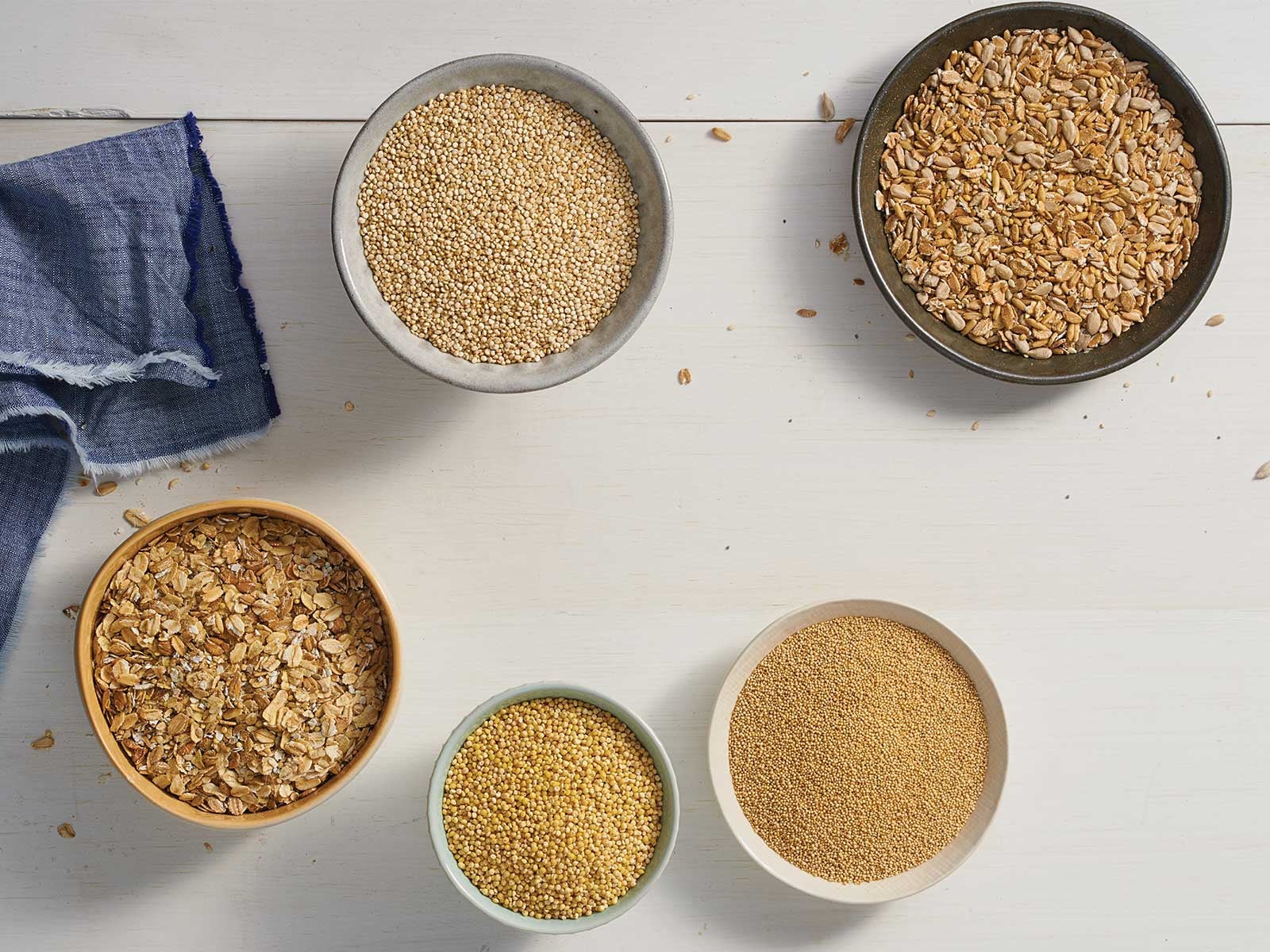
When adding coarse dry ingredients to a dough, I always presoak these additions, making what bakers call a “soaker.” Presoaking dense grains will ensure they don’t pull moisture from your dough, leaving you with a dense, brick-like loaf. Soaking also helps with digestibility and softens the grains for better eating.
Before we get into this, let me warn you that we’re going off road a little. If you’re not familiar with baker’s percentages or want a more direct route to a seeded loaf of bread, I recommend one of our reliable recipes like this Seeded Multigrain Sourdough Bread. My hope (if you come along for this ride!) is that by seeing how I make these changes, you might be emboldened to work beyond our recipes and employ your own ideas.
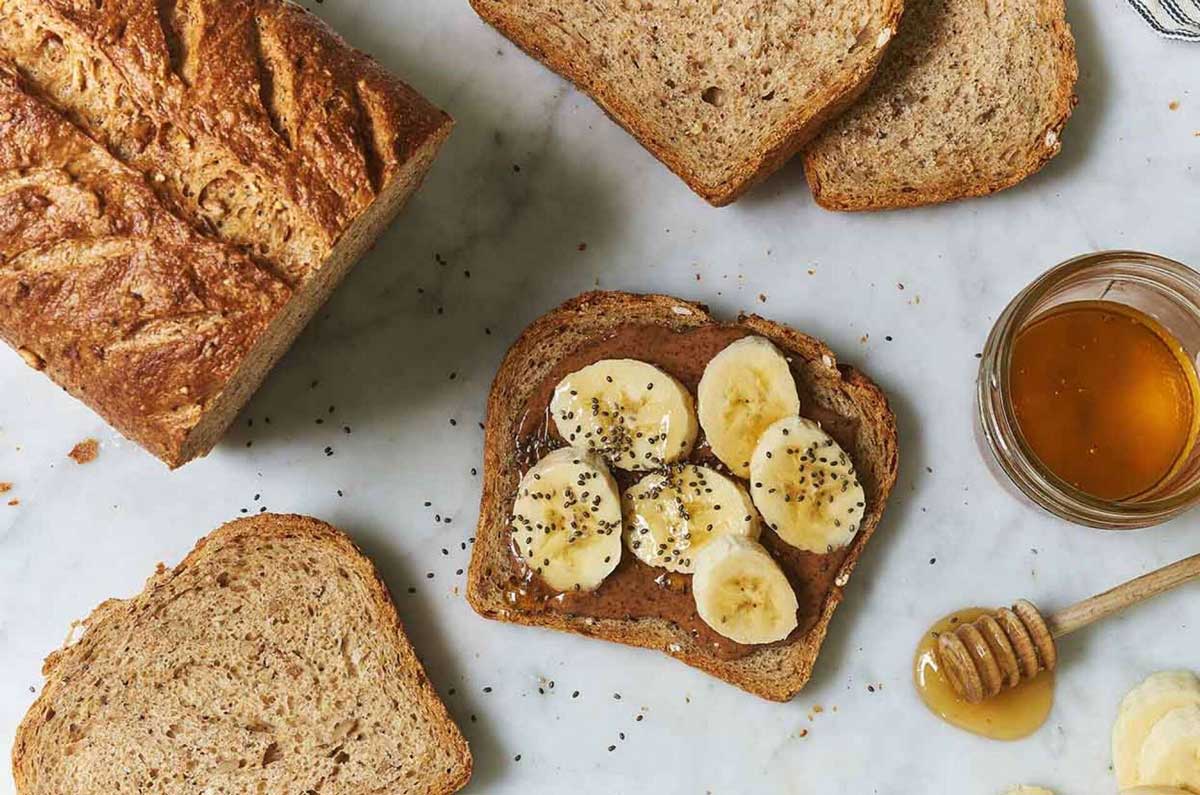
So let’s say that I want to make Maura’s Bread, but I want a multi-seed version. The first thing I do is find the total flour quantity. (This will be the sum of any flour used in the recipe, including preferments.) In baker’s percentages, I add grains at about 20% of the total flour weight. So for Maura’s Bread, which has 1,000 total grams of flour, I measure 200g of grain, mix them with equal weight water (200g) and soak for a couple of hours (or preferably overnight) before I mix the dough.
Depending on what you like, the 20% can go up or down — this is your recipe, right?!
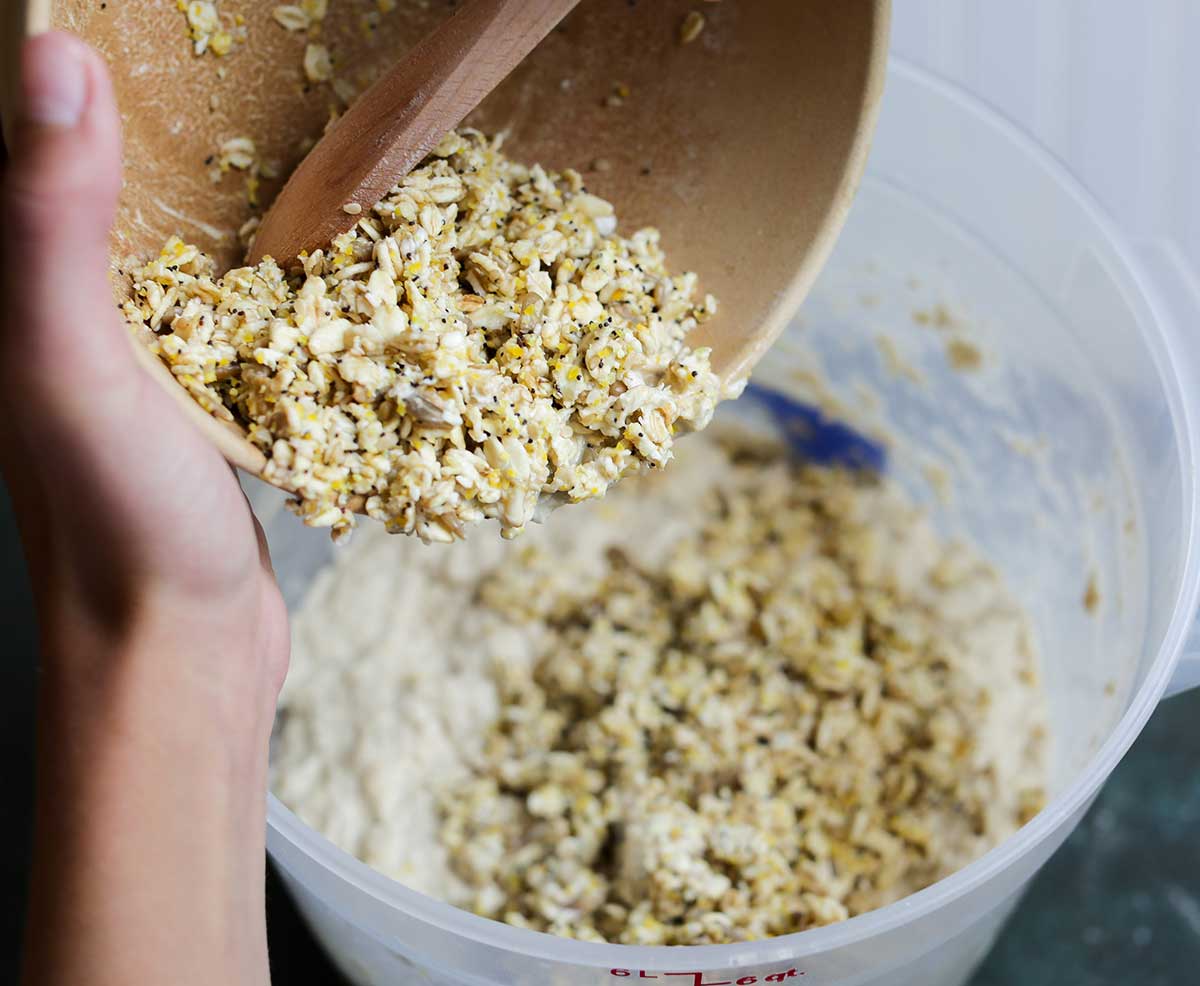
To add the grain, I recommend that you mix your bread dough as you would normally (without the grains). Toward the end of your mixing (whether working by hand or with a stand mixer), spread the soaked grains on top of the dough and fold to incorporate, working the dough until the mixture is roughly homogenous.
Pro tips:
Last but not least, flour offers endless options for alterations. Rather than sticking to the straight roads on the journey to best bread, let’s get off the highway and see what’s out there. In addition to my trusty bag of all-purpose, I keep whole rye, medium rye, spelt, whole wheat, golden whole wheat, cornmeal, and buckwheat in my pantry too. My collection is like the junk drawer in the kitchen — who knows what you’ll find!
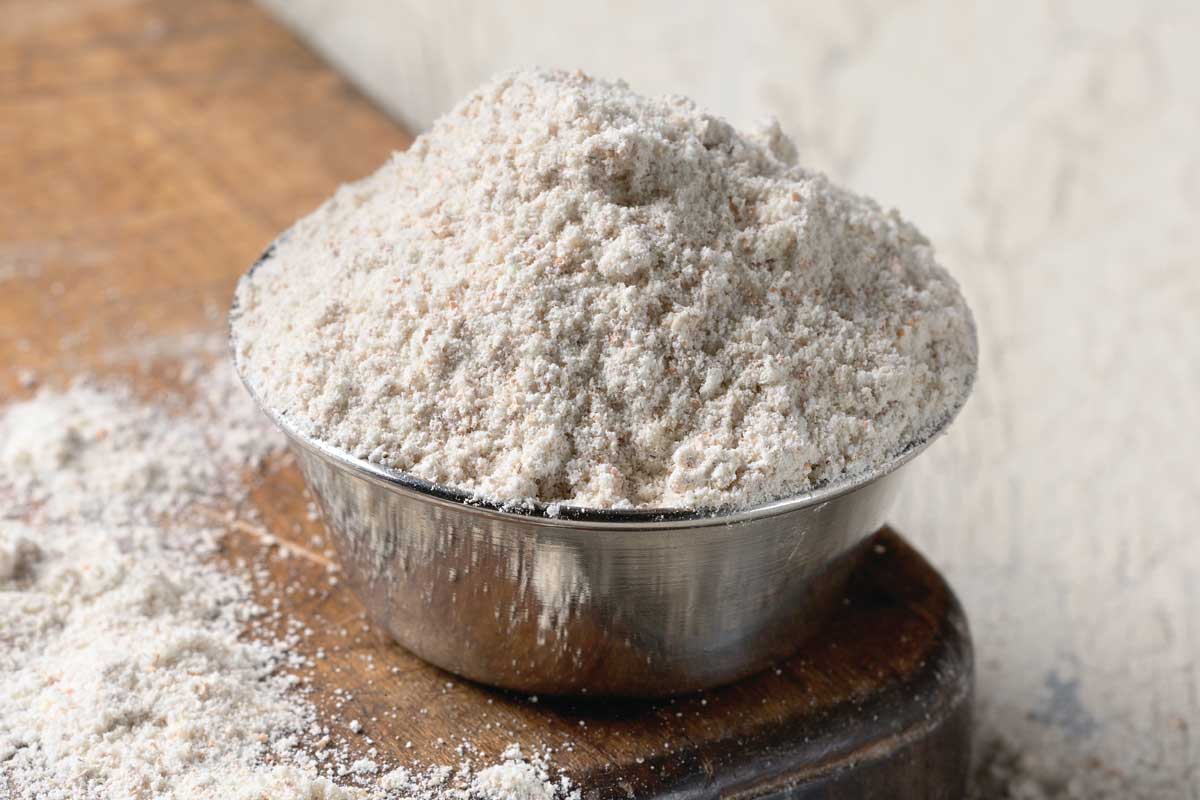
This is a good example of swapping “like with like.” What I mean is that if a recipe already has a portion of whole-grain flour, start there by subbing in a different whole grain. While every change has impacts, whole grains as a category tend to take roughly similar quantities of water, so this is an easy way to start playing around.
To spruce up a recipe that doesn’t contain whole grains (let’s use our Classic Baguette), I start by swapping in whole grains for around 10% to 15% of the total flour. The total flour in the baguette recipe is 538g so, from the amount of flour in the final dough (not the poolish) I’ll swap out about 53g to 80g of the all-purpose. I replace that portion with spelt, whole wheat, cornmeal, whatever I have on hand — these are all great options for adding color, flavor, and overall complexity to some of my basic all-purpose breads.
This week my wife made our bread using 85% all-purpose and 15% whole buckwheat. The crumb is beautifully gray-blue with just the faintest aroma of buckwheat — it’s been a real hit!
Pro tips:
Routines can be comforting, but they can also grow stale. So get out there and mix it up. Turn left instead of right on the morning stroll, wave to a neighbor that you haven’t met, maybe pick up a bag of seeds and add some to your trusty bread recipe — you may find yourself loving a new routine by the end of the week!
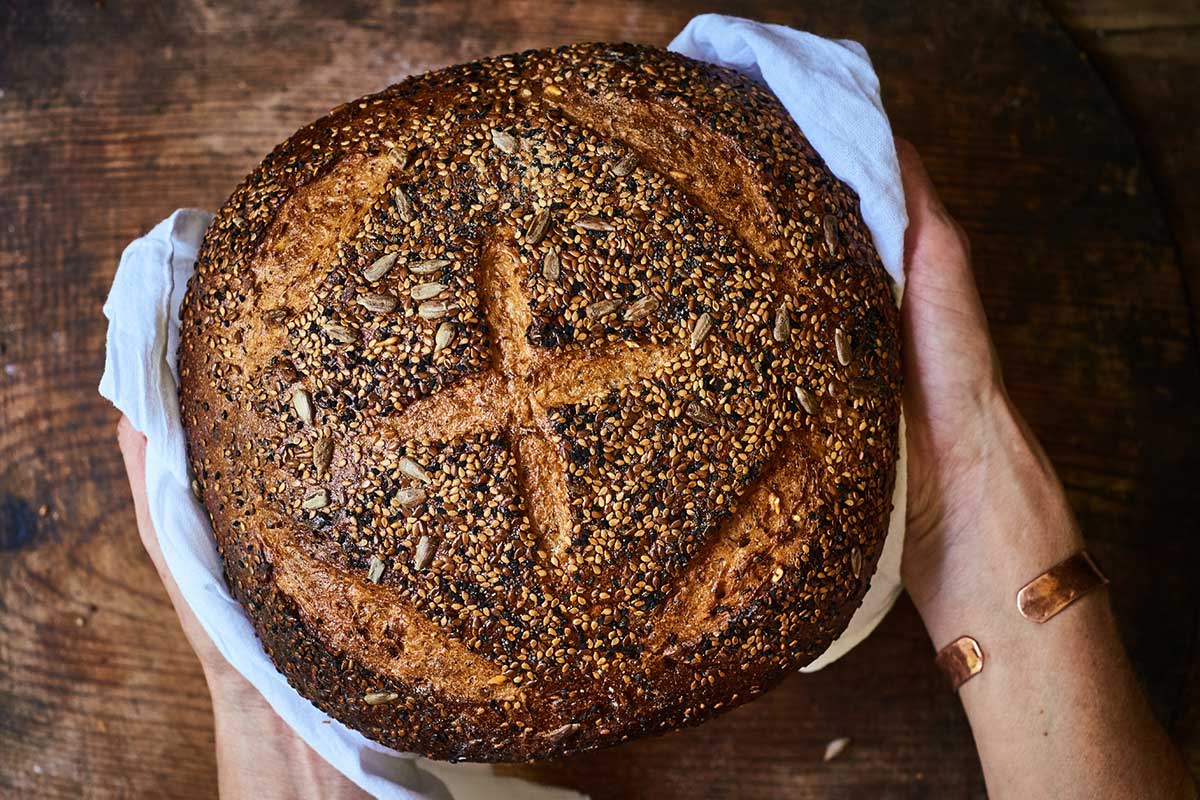
For more tips, tricks, and techniques to add to your bread-making practice, see our additional posts on artisan bread baking.
June 7, 2024 at 8:39am
I’ve not yet purchased a brotform, so am curious if this recipe can be baked in a 9x5 loaf pan.
Thank you for your reply.
June 8, 2024 at 3:09pm
In reply to I’ve not yet purchased a… by Linda Yerby (not verified)
Hi Linda, if you don't have a brotform, you could also use an appropriately sized bowl, lined with a close-weaved dish towel that has been generously dusted with flour (a half and half mixture of rice flour and unbleached all-purpose flour works well for this purpose). Or if you'd like to try making this recipe in pans, I'd suggest using two 9" X 5" loaf pans for the entire recipe. For best results, I would also recommend adding steam to the bake.
July 3, 2023 at 1:59pm
In your example of using soakers, you used 200g water for 200g of seeds. Is that 200g of water deducted from the total water needed for the bread recipe? I generally bake bread with 65 - 67% hydration.
July 3, 2023 at 2:26pm
In reply to In your example of using… by Mary (not verified)
Hi Mary, if you're more comfortable baking a recipe in the 65-67% hydration range you might want to reduce the dough water a bit, since the hydration of the Pain de Campagne (Maura's Bread) recipe (without the grain/seed soaker addition) is 80%. However, Martin generally finds that he doesn't need to adjust the dough hydration because, "once grains have grabbed moisture I never feel like it migrates much (at least in the breadmaking timeline)." Seeds might not be quite as absorbent as grains, so be sure to pour off any excess liquid from the soaker, and begin with a dough hydration you are relatively comfortable with.
July 12, 2021 at 8:33pm
Martin, I guess I'm stuck on the soaker idea. I'm trying to use cooked steel cut oats in a loaf of bread. Without the grain, the loaf is perfectly normal and works for me. With the grain added, it is very sticky and dense. I cant knead it. I keep putting more flour into the dough, but that doesn't seem to solve the problem. Even with all the aggravation, the loaf is immensely satisfying; very good taste, aroma and texture. What is your suggestion?
I can give you all the particulars if that is helpful to you envisioning my dilemma. Thanks.
Scudder
July 14, 2021 at 7:43pm
In reply to Martin, I guess I'm stuck on… by Scudder G. Stevens (not verified)
Scudder, when using a soaker you want to be sure that you take hydration from the original recipe to soak or cook your steel cut oats with. If you cook the oats prior with water outside of the recipe this will be increasing the final hydration of the dough and make it slack and sticky. When dealing with a slack dough, we have a great blog on Kneading a Wet Dough By Hand here: https://www.kingarthurbaking.com/blog/2017/06/19/kneading-wet-dough-by-hand. We have reached out to Martin to review your question and this response. When he has time to swing by he would be happy to offer an additional advice. Happy baking!
May 20, 2021 at 3:45pm
I have a 10-grain hot cereal blend I'd like to use in my usual sourdough bread recipe. It includes whole grain wheat, rye, triticale, oats, soybean, millet, barley, brown rice, oatbran, and flaxseed. Would you replace 10-15% of the flour with the blend directly or would it be better to make a soaker using 20% of the flour weight. Thanks!
May 21, 2021 at 12:57pm
In reply to I have a 10-grain hot cereal… by Belinda (not verified)
We're glad you enjoyed this post, Belinda! We'd recommend making a soaker with the cereal blend rather than replacing flour, the blend won't contribute much to the gluten structure so it'll be a better addition than a flour replacement. We hope this helps and happy baking!
February 13, 2021 at 11:07am
I’d love to hear more about adding things like spices, cheese, roasted fruits or veggies. With spices, do you add powdered spices or steep the water with them? With fruits/veggies, how much can you add and any tips on how to? Thanks as always!
February 23, 2021 at 9:49am
In reply to I’d love to hear more about… by James (not verified)
Hi James, you'll want to look at some of our recipes that include mix-ins as options like our No-Knead Harvest Bread, Easy Cinnamon Bread and our Pumpkin Yeast Bread. You can learn a variety of techniques from these recipes.
Pagination